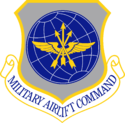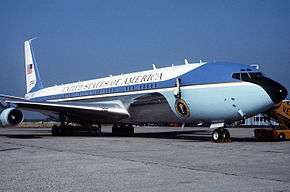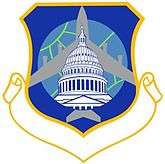76th Airlift Division
The 76 Airlift Division was a division of the United States Air Force, activated on 1 March 1976, inactivated on 30 September 1977, reactivated on 15 December 1980, and then inactivated again on 1 October 1985. Its principal components were the 89th Military Airlift Wing and the 1776th Air Base Wing.
76th Airlift Division
 | |
|---|---|
 VC-137 "Air Force One" of the division's 89th Military Airlift Wing | |
| Active | 1976–1977; 1980–1985 |
| Country | |
| Branch | |
| Role | Command of special airlift forces |
| Part of | Military Airlift Command |
| Insignia | |
| 76th Airlift Division emblem (Approved )[1] |  |
Operations
The division was formed as a restructuring of Headquarters Command, U.S. Air Force.
From 1976 through 1977, "and after 1980, the 76th provided airlift support for the President, Vice President, cabinet members, and other high ranking civilian and military dignitaries of the United States and other governments. Subordinate units also operated, administered and maintained Andrews Air Force Base, Maryland, and provided logistical support for the National Emergency Airborne Command Post (NEACP), and other flying units. One subordinate component, the 1st Helicopter Squadron, provided support for the United States Department of Defense, and the Defense Preparedness Agency plan for emergency evacuation of key government officials and to support the national search and rescue plan."[1]
Lineage
- Established as the 76 Airlift Division on 17 February 1976
- Activated on 1 March 1976
- Inactivated on 30 September 1977
- Activated on 15 December 1980
- Inactivated on 1 October 1985[1]
Assignments
- Twenty-First Air Force, 1 March 1976–30 September 1977.
- Twenty-First Air Force, 15 December 1980–1 October 1985[1]
Stations
- Andrews Air Force Base, Maryland, 1 March 1976–30 September 1977
- Andrews Air Force Base, Maryland, 15 December 1980–1 October 1985[1]
Aircraft
- Beechcraft C-12 Huron, 1976–1977, 1980–1985
- Boeing C-135 Stratolifter, 1976–1977, 1980–1985
- Sikorsky CH-3, 1976–1977, 1980–1985
- North American T-39 Sabreliner, 1976–1977
- Bell UH-1 Iroquois, 1976–1977, 1980–1985
- Beechcraft VC-6 King Air, 1976–1977[2]
- McDonnell Douglas VC-9 Skytrain II, 1976–1977, 1980–1985
- Convair VC-131, 1976–1977
- Boeing VC-135 Stratolifter, 1976–1977, 1980–1985
- Boeing VC-137 Stratoliner, 1976–1977, 1980–1985
- Lockheed VC-140 JetStar, 1976–1977, 1980–1985
- Beechcraft VC-6 Ute, 1980–1985
- C-20 Gulfstream III, 1983–1985[1]
Commanders
- None (not manned), 1 March 1976–30 June 1976
- Major General William C. Norris, 1 July 1976
- Major General Benjamin F. Starr Jr., 26 July 1977–30 September 1977
- Brigadier General Archer L. Durham, c.15 December 1980
- Brigadier General Albert C. Guidotti, 1 February 1982
- Brigadier General Paul A. Harvey, 22 August 1984–c.1 October 1985[1]
Emblem
Azure, a globe with axis bendwise celeste gridlined light green, surmounted in pale by a silhouetted aircraft ascending silver gray, overall coinciding with the edge of the globe in base, the US Capitol argent garnished of the first, all within a diminished bordure or. (approved c. July 1976)
References
Notes
- "Factsheet 76 Airlift Division". Air Force Historical Research Agency. October 5, 2007. Archived from the original on October 9, 2012. Retrieved April 1, 2014.
- The "V" prefix of these aircraft designate VIP transport and/or substitute/replacement/back-up Air Force One presidential transport aircraft.
Bibliography
![]()
- Ravenstein, Charles A. (1984). Air Force Combat Wings, Lineage & Honors Histories 1947-1977. Washington, DC: Office of Air Force History. ISBN 0-912799-12-9.